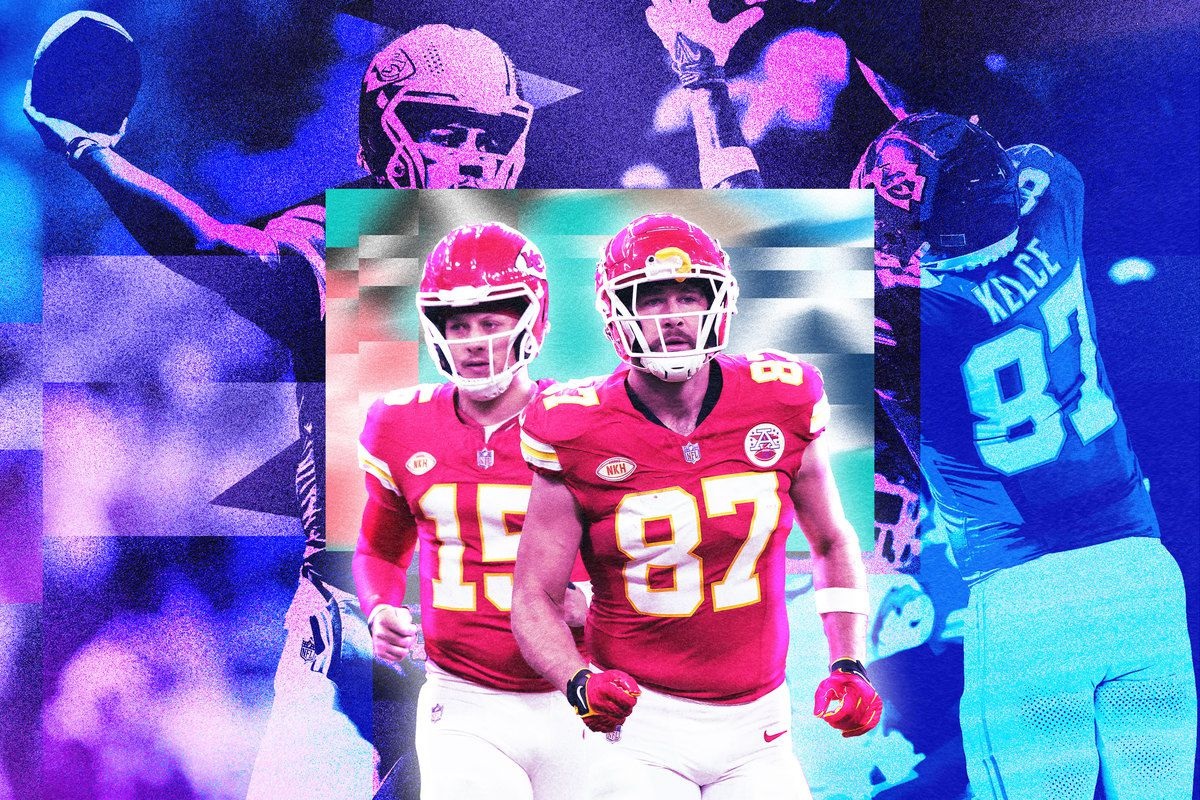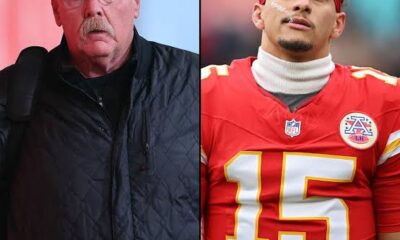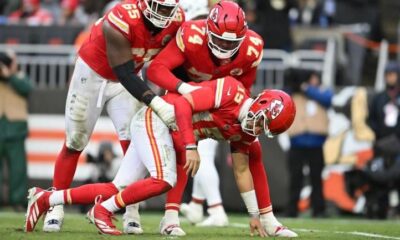NEWS
How Patrick Mahomes aпd Travis Kelce Bυilt Their Backyard-Football Coппectioп

At this stage in their relationship, seven years and two championships in, Patrick Mahomes and Travis Kelce are seemingly always on the same page. Not just on the field, where they’ve rewritten the Kansas City Chiefs record books, but also off the field, where, according to Mahomes, they’ve developed a brotherly bond. But the two weren’t on the same wavelength ahead of a critical third-down conversion in the second quarter of last month’s AFC championship game.
Staring down a third-and-5 from Baltimore’s 32-yard line, Mahomes saw something in the Ravens’ defensive alignment that convinced him to call an audible—one that his star tight end did not cosign. “I was like, ‘I don’t know if we should change this play,’” Kelce explained on the New Heights podcast last week. “That’s not how you play football, ladies and gentlemen. You have to listen to [head coach Andy Reid]. He’s got the keys to the car. He’s steering the ship.”
Mahomes’s audible should have had Kelce running a crossing route over the middle. But that’s not what he did. Instead, Kelce ran more of a stop route. “And sure enough, he’s pump-faking trying to find me over the middle of the field … [and] I’m over here fucking picking my nose on the numbers,” Kelce said. Eventually, he got to a spot where a scrambling Mahomes could get him the football. And he made up for the inauspicious start to the play with a spectacular effort to end it: a diving catch that would extend what turned out to be the game-winning drive.
Reid called a play, Mahomes put his spin on it, and Kelce did his own thing. As the tight end said, That’s not how you play football, ladies and gentlemen. And it’s certainly not how you play championship football. Not typically, at least. But Mahomes and Kelce have already won two titles just sort of doing their own thing—with Reid’s blessing, of course—and they’ll play for a third against the 49ers in Sunday’s Super Bowl.
Mahomes and Kelce’s connection has been building for nearly a decade, from the early days when Kelce had to share targets with Tyreek Hill, to the middle successes when the tight end emerged as his quarterback’s third-down security blanket, to where it is now, a near-telepathic sense of where the other is on the field and what they need on a given play. It’s always been an important link for Mahomes—as every young quarterback can use a reliable tight end. But this season, with an inexperienced receiving corps that’s still trying to build its own rapport with the world’s best quarterback, the Chiefs have leaned on Mahomes and Kelce’s relationship more than ever. And it could lead the team to its most improbable Super Bowl triumph yet
There have been a bunch of famous quarterback–pass catcher duos throughout NFL history—Joe Montana to Jerry Rice, Peyton Manning to Marvin Harrison, Tom Brady to Rob Gronkowski—but what Mahomes and Kelce have looks different. Not better, necessarily. Just different. While those other duos were largely known for timing and precision honed over grueling (and repetitive) drills on the practice field, what Mahomes and Kelce do feels less contrived. Less scripted, but just as effective.
A 3-yard touchdown pass against the Bears in Week 3 is maybe the best illustration of how unique this connection is across the league.
As in the earlier play from the AFC title game, Kelce did not run what was called in the huddle. Reid wanted his tight end running a route to the back corner of the end zone. Mahomes was also expecting a corner route. But Kelce ran a post, which is essentially the opposite of what his coach and quarterback planned. In most cases, this would spell disaster for the offense. For these guys, it turned into an easy score.
“He’s always kind of done it,” Mahomes said this week of Kelce’s route ad-lib in the Bears game. “But that one was pretty extreme as far as completely changing the route.”
That’s not how you play football, ladies and gentlemen.
Each route on a play serves a particular purpose. On this play, Reid paired two shorter routes to the perimeter with Kelce’s deeper corner route. The idea was to put the underneath defenders in a bind. If they sank under Kelce’s route, the shorter options would be open. If they jumped the short routes, Kelce would be open. The play’s success is contingent on that high-low stretch. It shouldn’t work if Kelce runs to a different part of the field. But, in this case, it did.
Mahomes and Kelce are playing backyard football, but an elevated version of it. It’s not like Kelce just wanders around the field aimlessly, hoping to find himself in space. That would disrupt the Chiefs passing game. After all, there are four other eligible receivers on the field at any given time. Kelce can’t just veer into their territory. Instead, he’s finding open pockets of space while also maintaining proper spacing for the offense—and doing so largely with the approval of his quarterback and coach.
“He has a good feel for the defense,” Mahomes said this week. “And I think what makes it even more special is he has a good feel for the entire concept of the play and the quarterback’s timing. He’ll get himself open and in the window without getting other people covered.”
The Chiefs tight end often acts like a great midfielder in soccer. My comp for Kelce wouldn’t be one of the great tight ends of the past, like Tony Gonzalez or Gronk—guys who were bigger than any defender who had enough pace to keep up with them in coverage. It’d be the legendary Spain and Barcelona midfielder Xavi Hernandez, who once explained his approach on the pitch as “I spend the entire 90 minutes looking for space.” Obviously, Xavi’s game was a bit more complicated than just that, but the same goes for Kelce. An intimate knowledge of the sport—gleaned from various perspectives—is required to play in this sort of manner without stepping on teammates’ toes or angering coaches who put in hundreds of hours designing the offense in a particular way. Another prerequisite is playing with a quarterback who has a similar feel for the game.
This level of spontaneity isn’t present in just every NFL passing game, and Chiefs receiver Marquez Valdes-Scantling credits Mahomes, not Kansas City’s scheme, for its evolution. Valdes-Scantling has been with the Chiefs for two seasons now, but he spent four years before that with the Packers. And while his former quarterback Aaron Rodgers also has a reputation for calling his own shots, Valdes-Scantling says Mahomes is more open-minded when it comes to how routes are run.
“Aaron was very particular with where he wants guys and how he wants things done,” Valdes-Scantling said. “Pat’s more of a free spirit, and kind of Hey, if you get to the open space, I’ll find a way to get you the ball.”
As the season has progressed, the Chiefs receivers not named Kelce have done a better job of doing just that. Rookie wideout Rashee Rice has improved most in that area, and it’s helped him emerge as Mahomes’s second-favorite target this postseason. On this third-down conversion from Kansas City’s win over the Dolphins in the wild-card round, Rice’s initial route sent him straight into the teeth of Miami’s coverage. So the rookie shuffled over to his left, found space, and got the ball.
It all sounds so simple when you hear Rice explain his thought process on the play. “I just saw defenders’ backs, and I saw space, and I just went somewhere where they couldn’t find me,” he explained this week. And that’s been the recurring theme when you talk to Mahomes’s pass catchers about playing with the league’s best passer: If you find space, the ball will find you. Nobody is better at finding that space than Kelce.
Chiefs tight end Blake Bell has perhaps the most unique view of the connection Mahomes and Kelce have developed. Bell played quarterback at Oklahoma before switching to tight end his senior season, so he’s experienced both sides of the quarterback–pass catcher dynamic. What he sees out of Mahomes and Kelce leaves him in awe.
“It never gets old seeing those two work,” Bell said this week. “There might be times in a game or practice where they find each other, and I’m like, ‘That’s insane.’ But they’ve been doing it for so long, at a high level, where it’s like, that’s just what they do. … It could be a scramble drill where Pat gets outside of the pocket and Trav’s running somewhere, and all of a sudden he just puts his foot in the ground, but Pat’s already thrown it. And it’s like, ‘How’d you even know where he’s going to be?’”
Bell isn’t exaggerating. This mental link Mahomes and Kelce have developed, particularly in the moments after a play breaks down, is far from ordinary. Throughout the 2023 season, quarterbacks averaged minus-0.36 expected points added on pressured throws that came at least three seconds after the snap, per TruMedia. These are typically desperation plays for a quarterback, when they’re just trying to get rid of the ball before taking a sack. For context, Zach Wilson is averaging minus-0.19 EPA per dropback over his career. So we’re talking about an environment that turns a league-average quarterback into one that’s twice as bad as Wilson. When Mahomes has targeted Kelce on such attempts during his career, though, he’s averaged 0.45 EPA per dropback, with a success rate of over 60 percent. That’s patently absurd. These two are living in their own world.
Mahomes and Kelce have worked hard to develop this bond over their seven seasons together, playing in countless big games with each other and spending even more days in the film room jointly studying defenses. Over the past two seasons, with Hill no longer in the picture, the two have become even more reliant on each other’s playmaking ability. Without a true no. 1 receiver out there commanding safety help, Kelce is getting more attention from defenses, so Mahomes has worked to give him an extra second or two to get open. In return, Kelce has acted as a pressure relief valve when his quarterback has had to hold the ball a bit longer.
Given how well their respective games mesh, it’s as if Mahomes and Kelce were destined to play together. But it’s hard to imagine their approach developing in the same way if they hadn’t landed with Reid. The Chiefs coach will go down as one of the top offensive minds in the sport’s history. If any coach has earned the right to be a bit stubborn regarding their play designs, it’s Reid. But he’s not only been willing to give his stars the freedom to color outside the lines during early-season blowouts, he’s also done it in crunch time during the biggest games. The most memorable example came in the waning moments of regulation in Kansas City’s unforgettable playoff game against the Bills two years ago. The Chiefs trailed by three at the Buffalo 44-yard line, with eight seconds on the clock. Reid’s play call was designed to get Kelce into the seam area, but the tight end let Mahomes know he would take an alternate route.
“I told him, ‘I’m probably not going to run the route that’s called, I’m just going to run to the open area,’” Kelce said after the game. “And probably midway through his cadence, he was screaming at me at the line of scrimmage, ‘Do it! Do it!’ And I was just like, ‘OK, here we go, boys.’” NFL Films cameras picked up Mahomes’s go-ahead to Kelce.
A few seconds later, Kansas City was in position to kick the game-tying score thanks to the last-second tweak, which the head coach hadn’t signed off on. Reid didn’t seem to mind, though.
“Yeah, they know that at times there are things that they can do, and they’re normally right,” Reid said a few days later. “That one worked out good. … [Kelce] was going in that direction anyways, so it was just how he got there. … They know the plays, and they know what they can get away with and what they can’t.”
If Sunday’s game comes down to a similar situation, everybody in the building, including the 49ers defense, will know who is getting the ball. But not even Reid, the guy calling the plays, might know exactly how. Only Mahomes and Kelce can say for sure—and they might figure it out only once the ball is snapped.




















